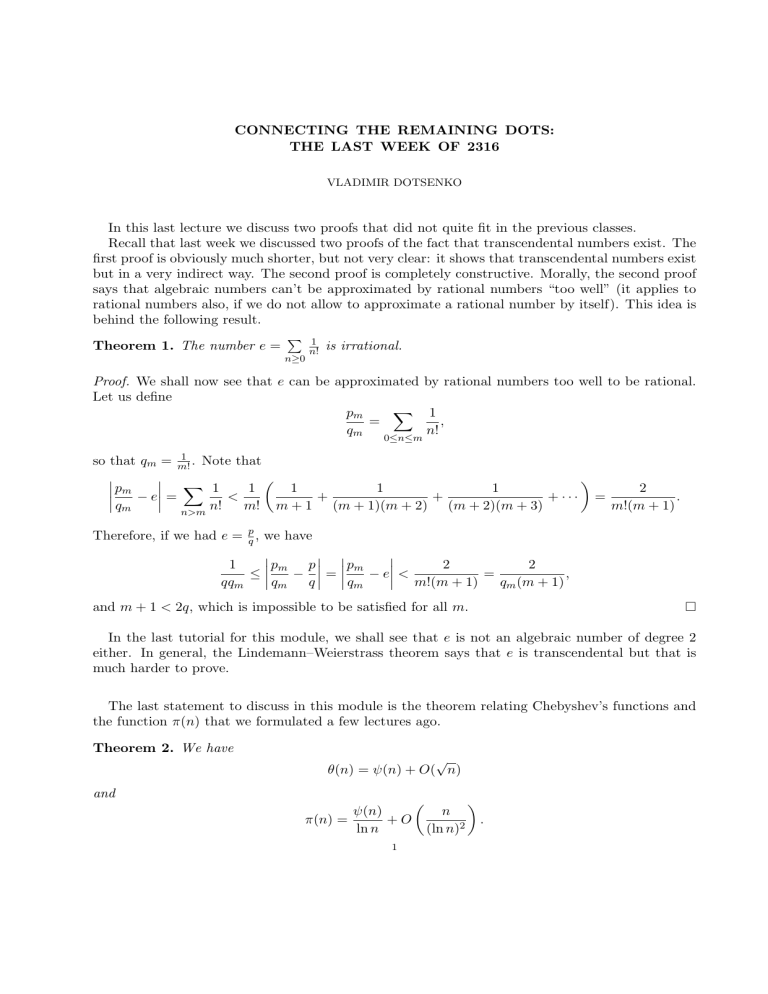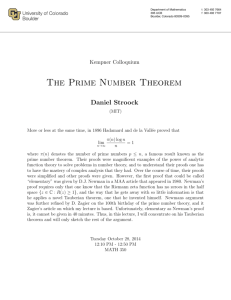CONNECTING THE REMAINING DOTS: THE LAST WEEK OF 2316

CONNECTING THE REMAINING DOTS:
THE LAST WEEK OF 2316
VLADIMIR DOTSENKO
In this last lecture we discuss two proofs that did not quite fit in the previous classes.
Recall that last week we discussed two proofs of the fact that transcendental numbers exist. The first proof is obviously much shorter, but not very clear: it shows that transcendental numbers exist but in a very indirect way. The second proof is completely constructive. Morally, the second proof says that algebraic numbers can’t be approximated by rational numbers “too well” (it applies to rational numbers also, if we do not allow to approximate a rational number by itself). This idea is behind the following result.
Theorem 1.
The number e = P n ≥ 0
1 n !
is irrational.
Proof.
We shall now see that e can be approximated by rational numbers too well to be rational.
Let us define p m q m
=
X
0 ≤ n ≤ m
1 n !
, so that q m
=
1 m !
. Note that p m q m
X
1
− e = n>m n !
1
< m !
1 m + 1
Therefore, if we had e = p q
, we have
+
1
( m + 1)( m + 2)
+
1
( m + 2)( m + 3)
+ · · · =
2 m !( m + 1)
.
1 qq m
≤ p m q m
− p q
= p m q m
2
− e < m !( m + 1)
=
2 q m
( m + 1)
, and m + 1 < 2 q , which is impossible to be satisfied for all m .
In the last tutorial for this module, we shall see that e is not an algebraic number of degree 2 either. In general, the Lindemann–Weierstrass theorem says that e is transcendental but that is much harder to prove.
The last statement to discuss in this module is the theorem relating Chebyshev’s functions and the function π ( n ) that we formulated a few lectures ago.
Theorem 2.
We have
θ ( n ) = ψ ( n ) + O (
√ n ) and
π ( n ) =
ψ ( n ) ln n
+ O
1 n
(ln n ) 2
.
Proof.
To prove the first statement, we note that
0 < ψ ( n ) − θ ( n ) =
X p m ≤ n ln p −
X ln p = p ≤ n
=
X p ≤
√ n ln p
X
2 ≤ m ≤ ln n/ ln p
1 ≤
X p ≤
√ n ln p ln n ln p
=
= π
√ n ln n = O
√ n ln
√ n ln n = O (
√ n ) .
To prove the second one, we define θ for all positive real numbers by θ ( x ) = θ ( b x c ), and write
π ( n ) =
X p ≤ n,p prime
1 =
X p ≤ n,p prime
1 ln p ln p
= n
X
( θ ( k ) − θ ( k − 1)) ln k k =2
1
=
=
θ ( n ) n
− n − 1
X
θ ( k )
1 ln( k + 1)
−
1 ln k
=
θ ( n ) n
−
Z n
2
1
θ ( t ) − t (ln t ) 2 dt = k =2 because from Chebyshev’s bounds it follows that θ ( t ) = O ( t
=
θ ( n n
)
+ O
Z n
2
1
(ln t ) 2 dt ,
). The integral
R n
2
1
(ln t ) 2 dt can be estimated as follows:
Z
2 n
1
(ln t ) 2 dt ≤
Z
2
√ n
1
(ln 2) 2 dt +
Z n
√ n
(ln
√ n ) 2 dt = O (
√ n ) + O
(ln
√ n ) 2
= O n
(ln n ) 2
, and the proof is complete.
Corollary.
The following three statements are equivalent:
π ( n ) ∼ n ln n
,
θ ( n ) ∼ n,
ψ ( n ) ∼ n.
Remark.
The first statement n
π ( n ) ∼ ln n is usually referred to as Prime Number Theorem. It also is equivalent to the statement M
µ
( n ) =
P o (1) , or µ ( k ) = o ( n ) .
k ≤ n
A sharper form of Prime Number Theorem that we one can infer from above states that
π ( n ) = n ln n
+ + O n
(ln n ) 2
.
An even sharper form of Prime Number Theorem states that for a fixed α < 3 / 5 we have
π ( n ) =
Z n
2 dx ln x
+ O ne
− (ln n )
α
.
A conjectural strong form of Prime Number Theorem states that for any fixed > 0 we have
π ( n ) =
Z n
2 dx ln x
+ O n
1 / 2+
2
.
The asymptotic behaviour of σ ( n ) is quite mysterious and is connected to several open problems.
One very elementary sounding one is the following. Let H n
= P k ≤ n
1 k
. Then conjecturally
σ ( n ) ≤ H n
+ ln( H n
) e
H n .
It was proved by Jeffrey Lagarias in 2002 that this statement is equivalent to the Riemann Hypothesis, one of the most famous unsolved problems in mathematics. The original statement of the
Riemann Hypothesis is as follows. Consider the function
ζ ( s ) =
X
1 n s
.
n ≥ 1
This, as a function of s , is defined for all complex values with real part greater than 1. It turns out that it is possible to extend this to an analytic function defined for all s = 1 (with a first order pole at s = 1). This function is equal to zero to some values of s , namely for all negative even values.
The Riemann hypothesis conjectures that all other zeros of ζ ( s ) have real part equal to 1 / 2. It has been known for a long time that behaviour of zeros of ζ ( s ) controls asymptotics of arithmetic functions. For example, the fact that ζ ( s ) has no zeros with real part equal to 1 is used to prove
Prime Number Theorem, and the statement
π ( n ) −
Z n
2 dx ln x
<
1
8 π
√ n ln n for all n ≥ 2657 (a precise version of the conjectural strong form of Prime Number Theorem mentioned above) is equivalent to the Riemann hypothesis. Another asymptotic statement equivalent to the Riemann hypothesis is
| ψ ( n ) − n | <
1 √ n (ln n )
2
.
8 π
A way to formulate the Riemann hypothesis via the µ function is the claim that for every positive we have
X
µ ( k ) = O ( n
1 / 2+
) .
k ≤ n
3







